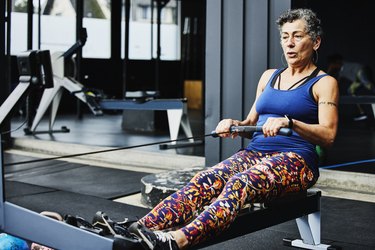
While not always the most popular piece of gym equipment, the rowing machine should absolutely make it into your gym cardio routine. It offers a complete, full-body workout by targeting a wide range of muscles in your upper and lower body as well as your core.
Plus, rowing machines are an accessible option for those seeking an impact-free workout that won't stress the joints with excessive force like other higher-impact workouts like running. But that doesn't mean it's easy. Rowing is an intense full-body workout that spikes your heart rate and builds your strength.
Video of the Day
Video of the Day
Q: What muscles does rowing work?
A: The muscles used in rowing include the deltoids, biceps and triceps, glutes, quadriceps, hamstrings and calves.
Rowing Machine Muscles Targeted
Rowing on the machine targets multiple muscles in one workout using the following actions: the catch, the drive, the finish and the recovery.
During the catch, the triceps work to extend the arms and the flexor muscles in the finger grips around the handles of the rowing machine. Your hip flexors are used to hinge your torso forward.
Next is the drive, where the powerful leg muscles such as the quadriceps initiate the action of pushing your feet away from the machine's platform. Your shoulder and back muscles contract as your biceps pull the rowing machine's handles to move in toward your abdomen. At the same time, your erector spinae, glutes, quads and hamstrings engage to extend your body away from the machine.
In the finish, your upper body leans back slightly, as it is supported by the muscles of your core. Your legs are extended with your hands holding the rowing machine's handles in close to your body, near your lower ribs. Your grip is relaxed as your shoulders are low and aligned with your wrists, which are parallel to the ground.
During the recovery, your abdominals stabilize the rest of your body, while your calves, hamstrings and hip flexors contract to return your feet to the platform. Your core muscles contract to keep your torso upright. Your triceps engage to push your arms forward, moving them away from your body, as your abdominals flex your torso forward.
Proper Rowing Machine Technique
If your rowing technique is correct, you can build muscles all over your body with a rowing machine. But proper rowing technique doesn't always come naturally for people. To make the most out of your workout, follow these steps as you use the machine — and check out this instructional video from rowing machine manufacturer Concept2.
- Catch: The catch is the position when you're sitting with your legs pulled in toward you, your torso leaned forward and your arms extended.
- Drive: Push off the platform with your entire foot, including your heel, to prevent straining your knee joints. As you extend your legs, drive with your legs, not your arms.
- Finish: Hinge back slightly from the hips, then finish the motion by pulling the handle in toward your chest with your arms.
- Recovery: As you slide forward to begin the stroke again, make sure to begin by moving your arms, then your torso, then your legs (the opposite order that you moved them during the drive).
Tip
One crucial element to note in this stroke is the order in which it's performed. First, your legs drive you back, then your torso moves, then your arms in a quick, smooth progression.
Other Rowing Machine Workout Benefits
One rowing machine benefit is that it can lead to an increase in overall muscular strength. According to the American Council on Exercise (ACE), rowing machines offer a full-body cardiovascular workout that involves multiple muscle groups.
Perform movements on the rowing machine using the proper technique to build and strengthen muscles all throughout the body. Utilizing the correct technique and proper alignment will also keep the body in check, preventing excessive impact from jarring joints.
Rowing for Better Health
The Centers for Disease Control and Prevention recommends at least 150 minutes of moderate intensity aerobic activity, 75 minutes of vigorous aerobic activity or an equivalent mix of the two each week in order to stay healthy. Using a rowing machine can help you meet this goal.
The ACE outlines different workouts you can try with the machine, using meters, time or strokes as a barometer for how much you're working. They also suggest setting a reasonable level of resistance on your machine, so you're working hard without feeling like your form is being compromised.
Performing a higher intensity interval training pyramid workout can also be done on a rowing machine, according to the Mayo Clinic. This type of vigorous aerobic exercise won't cause wear and tear on your joints. Unlike other aerobic activities such as running, the rowing machine is a good option for anyone with sensitive joints or issues such as arthritis, as it is a low-impact activity.
Hop on the rowing machine the next time you want to challenge your whole body to a workout that combines calorie-burning cardio exercise with strength training.
- Concept2.com: "Rowing and Your Muscles"
- Concept2.com: "The Biomechanics of Rowing"
- American Council on Exercise: "Reap the Benefits of Rowing"
- Mayo Clinic: "HIIT Pyramid Workout"
- Centers for Disease Control and Prevention: "Physical Activity for a Healthy Weight"
- Concept2.com: "Indoor Rowing Machine Technique"